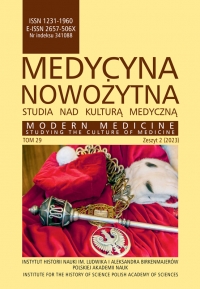„Mortui vivos docent” – badania anatomiczne w starożytnej medycynie greckiej
„Mortui vivos docent” – anatomical studies in Ancient Greek medicine
Author(s): ANETA LIWERSKA-GARSTECKASubject(s): Archaeology, Social history, Ancient World
Published by: Wydawnictwo Uniwersytetu Jagiellońskiego
Keywords: anatomical studies; autopsy; Ancient Greek medicine; Celsus; Galen; Herophilos; Erasistratos;
Summary/Abstract: Systematic dissection of human corpses only began to be practised in modern times. In the ancient world, the dead body was burdened with impurity and had to be buried with dignity so that the relatives of the deceased would not be affected by the taint. For this reason, anatomical studies were mainly based on observation of the wounded on the battlefield or on autopsies of animal bodies. On this basis, conclusions were drawn about human anatomy and bodily functions. The exception was Alexandria during the Hellenistic period, which became the dominant scientific centre, especially during the reign of the first three Ptolemies. It was there that Herophilos and Erasistratos, physicians who, would dissect human cadavers, were active. Their writings have survived only in small fragments, but from later sources we learn of their significant achievements in anatomical research. Particularly relevant here is the testimony of the Latin encyclopaedist Celsus, who, while understanding the necessity of dissecting examinations, disapproved of the vivisections allegedly performed by Alexandrian scholars. In the Roman period, dissection of human cadavers was no longer practised, not only because of the impurity of the human body, but also because the new trend in medicine, empiricism, abandoned the search for the causes of disease, focusing mainly on the treatment of visible symptoms.
Journal: Medycyna Nowożytna Studia nad Kulturą Medyczną
- Issue Year: 30/2023
- Issue No: 2
- Page Range: 119-129
- Page Count: 11
- Language: Polish

